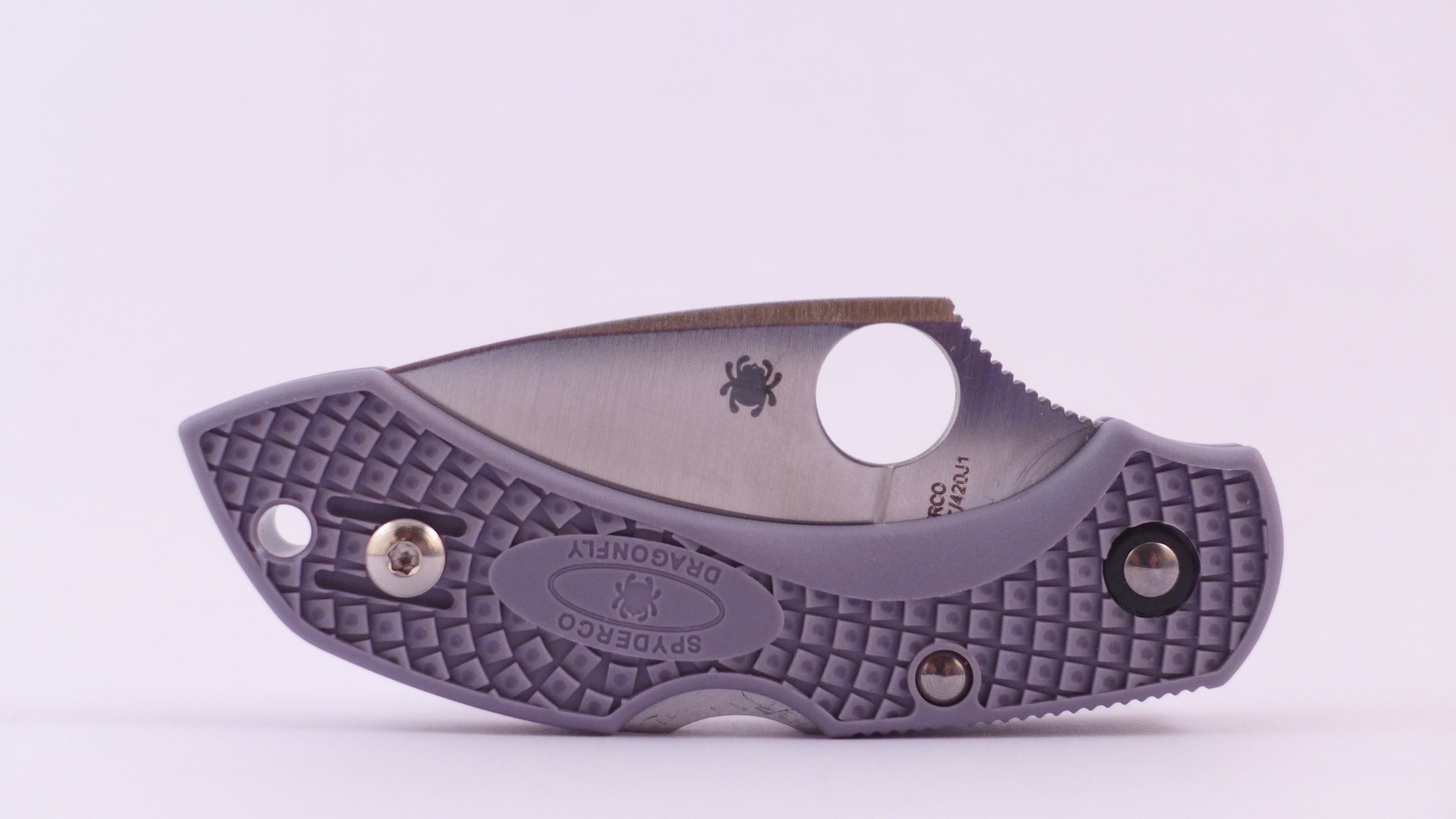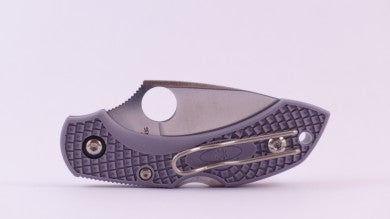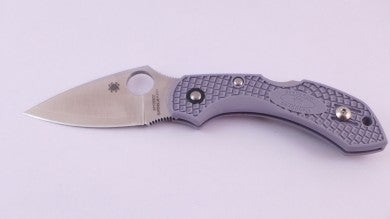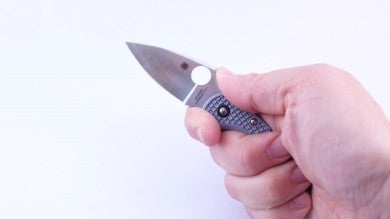Spyderco Dragonfly 2 Super Blue Review
Tony Sculimbrene 07.23.14

In today’s knife world, there is a relentless drive towards better steels. S30V, a top choice even four years ago, is now a common steel. The power of powder metallurgy (a process whereby very pure steel “dust” is pressed and heated to create very pure steels) has given steel companies the ability to tweak recipes on a molecular level. This, in turn, gives them the ability to alter a steel’s performance in a myriad of ways. Nearly all of the best steels ever made (in terms of performance) have been made recently. M390, M4, 3V, ZDP-189, S35VN, CTS XHP, and CPM 154 all come tantalizingly close to being “the perfect steel,” each with an impressive array of aspects that make them all very tough, very hard, and very corrosion resistant.
But Yasuke Specialty Steels, a branch of Hitachi, has been chugging along for centuries making a few different grades of steel that all start out with ultra pure sand iron deposits. Long a favorite of Japanese wood working tools (such as these beautiful Japanese axes), these iron sand steels all have very low levels of impurities.
Iron sands have been used in Japanese steel since the time of the samurai, and even in today’s market place, these iron sand steels are still remarkably competitive. Yasuke makes three grades of iron sand steels for Hitachi–white, blue, and Super Blue. Of these, Super Blue is the best performer–very pure with some added chromium to make it more stain resistant. Named for their paper wrappings and not the color of the steel, these iron sand steels are the steels of legend.
Super Blue comes in at 63-65 HRc, which is essentially the same HRc as ZDP-189. It is not quite as stain resistant as ZDP-189 or M390 (another super hard steel), but what it lacks in corrosion resistance, it makes up for in its ease of sharpening. Thanks to a very uniform grain structure, Super Blue is about as hard to sharpen as VG-10, despite its very high hardness. In short, Super Blue competes nicely with the best powder steels despite the fact that it is closely related to steels over a five hundred years old.
Spyderco has recently released a Sprint Run series of their best selling folders with Super Blue steel. Starting with the Mule and going through the Caly3, they finally released a Super Blue Dragonfly 2 in May of this year. Given my love for the Dragonfly 2 design and the impressive performance of Super Blue, it was a hard package to pass up. Here is the review.
Description
The Dragonfly 2 is an updated version of the original Spyderco Dragonfly (technically it is the third upgrade, the first being limited to moving the thumb hole out to the now standard 1.1 inch distance from the pivot, something common to all modern Spydercos). The Dragonfly is a very light (1.2 ounces) and very is a well designed knife. Perhaps the embodiment of Spyderco’s “Little Big Knife” idea, the Dragonfly allows for a full four finger grip, yet tucks into a pocket so well that it is unnoticeable.
Here is the product page for the Super Blue version, which is a Sprint Run (or limited edition in Spyderco parlance). The blade steel here is a laminate with a core of Super Blue steel and sides of 420J. The handle is dove gray FRN. There is an over-the-top, deep carry pocket clip.
The knife has jimping on the thumb ramp and the choil. The choil gives the knife an amazing amount of control. The blade is full flat ground, just over 2.25 inches long, and the classic Spyderco leaf-shape blade.
Testing
After two months of pretty consistent use in an EDC role, the Dragonfly has proven once again why it is one of the best production knives out there. The design is just so solid. Given the number of Dragonflies I have owned, the only real question mark was the Super Blue steel. It is a high carbon steel and though there are added lumps of chromium to make it more stain resistant, it does have a reputation for coloring quickly. In my two months of use, the edge has remained sharp and the Super Blue has developed only the lightest of patinas. There is no question, however, that Super Blue is the sharpest steel I have ever used.
Out of the box, the Dragonfly was parting cardboard like it was cellophane. We had to unpack some large pieces of furniture and the Dragonfly zipped through them with ease, leaving an edge on cardboard that looked like it was created by an industrial cutter. In short, the cutting performance is insane and the corrosion issues aren’t bad at all. I still haven’t had to sharpen the Super Blue, but I have stropped it and it did very well on the leather, coming back to a hair whittling edge in a minute or two.
Design
The size and shape of the Dragonfly makes it an ideal EDC. The Gen 2 improvements were good, the jimping is fine, and the clip is much better (this being the last Spyderco to have the molded FRN clip). There is simply nothing to complain about in terms of design. This is a true four finger knife, despite its incredibly compact package. It’s almost like there is some kind of magic trick at work.
Ounce for ounce the Dragonfly cannot be beaten. With a great steel in the blade you have what I think is the finest EDC knife available. The Super Blue is just such a steel and the overall package is amazing. Every detail is thought out, from the rounded handle scales to the logo under the clip to prevent pocket shredding. This is a great knife design.
Implementation
Spyderco has the Dragonfly form down pat. There are no stray elements, and the blade is perfectly centered and nicely finished. The pivot here is especially noteworthy. It is silky smooth, so smooth in fact that it snaps back into the handle as the blade is being closed. The pocket clip is truly excellent, combining discretion and retention into a single, perfect design.The thumb hole is placed perfectly and allows for effortless deployment. Simply put, there is nothing to complain about here. This is an awesomely finished knife, and it does carry that small bump up in attention that accompanies most Spyderco Sprint Runs.
Conclusion
Simply put, the Super Blue Dragonfly 2 is an awesome EDC knife, probably one of the best ever. The steel is deserving of all its praise found on the Internet. The only real competition for the Super Blue Dragonfly is the ZDP-189 Dragonfly (aside: I’d love to see an M4 Dragonfly). If you can tolerate the potential for some patina, the Super Blue is an amazing performer, cutting like nothing else. If you can’t take a bit of color on your blade, the ZDP-189 version is an easy choice.


